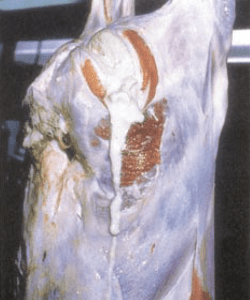PRICE premiums for sheep and lambs vaccinated against the bacterial disease Cheesy Gland should be considered to help reduce its prevalence, a leading sheep veterinarian has proposed.
Australian Veterinary Association spokesperson and leading production scientist, Dr Graham Lean, said more needed to be done to reduce the disease’s prevalence, including wider vaccination and research into the disease’s productivity and animal welfare impacts.
Cheesy Gland or Caseous Lymphadenitis (CLA) sheep is the cause of significant losses to the Australian sheep industry, despite the introduction of a vaccine nearly 30 years ago.
“Despite limited data on vaccine usage in Australia, it’s estimated that only two per cent of flocks nationally are fully vaccinated, despite the vaccine being 99 percent effective,” Dr Lean said.
“Recent data has estimated the economic losses due to CLA to be around $30-40 million across the national flock.
“This includes the costs of carcass inspection, rejection of carcases presenting with the disease and reduced wool income.”
According to Dr Lean, part of the problem for farmers is the perceived lack of value in vaccinating.
“Buyers in sale yards average down the price of all sheep purchased to take into account the proportion that will have to be trimmed and rejected at slaughter.
“However, for farmers selling directly to abattoirs, they should be able to negotiate a premium price if their flock has been vaccinated against CLA,” he said.
“And in theory, if the whole industry implemented an effective vaccination program, then every farm would benefit, as the benefits in processing efficiency would be reflected in a higher price for sheep meat and mutton in particular.
“It also seemed likely, although not substantiated scientifically, that body weight loss from CLA-affected ewes could impact on productivity and financial returns.”
Dr Lean said that further research was required to learn more about the disease, with body weight loss a good example.
“We need to know more to demonstrate to sheep farmers that there’s an immediate on-farm benefit from implementing a full CLA vaccination program.
“This includes animal welfare considerations.”
According to the Livestock Biosecurity Network, vaccination is the most important tool in preventing CLA infection in unaffected sheep. Lambs are usually vaccinated firstly at marking and then 4-6 weeks later, followed by an annual booster ideally 4-6 weeks before shearing.
LBN said CLA could reduce clean fleece weight by up to 7pc in the year of infection. Chronic infection can cause ill-thrift, emaciation and poor reproductive performance.


HAVE YOUR SAY